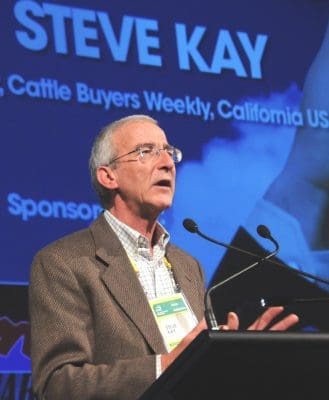 A monthly column written for Beef Central by US meat and livestock market commentator Steve Kay, publisher of US Cattle Buyers Weekly
A monthly column written for Beef Central by US meat and livestock market commentator Steve Kay, publisher of US Cattle Buyers Weekly
United States beef packers are being investigated by the USDA, the US Justice Department and others for any illegal market behavior when the COVID-19 pandemic caused the US processing industry to virtually shut down for two months back in April. Fed cattle prices fell sharply at the time, as slaughter-ready cattle backed up following a wave of temporary closures, while retail meat prices moved sharply in the opposite direction.
How startling, then, that US packers have performed a minor miracle by returning to full production levels by mid-June.
As I wrote last month, supply and demand factors determined the direction of live cattle and wholesale beef prices in April and May. These factors were extreme. But nothing suggests that packers did anything that broke any law. Perhaps their best rebuttal to investigators is to show how quickly beef production has returned to normal.
The fate of both the feeder cattle and grainfed cattle markets rests on the ability of packers to process fed cattle on a timely basis and offer an orderly flow of beef to end-users at a reasonable price.
All that blew up from late March to mid-May. But there has now been a dramatic turnaround that has brought sighs of relief from everybody from feedlots to retail meat departments.
Looking back, weekly US slaughter levels reached a record low of 438,614 head the week ended May 2. This was 64pc of available capacity, using a maximum capacity of 685,000 head per week. Weekly slaughter levels improved each full week in May. But questions remained as to how long it would take for packers to operate at full capacity again.
The miracle is that they achieved that in June. The slaughter total for the week ended June 29 was nearly 665,000 head, 97.5pc of maximum capacity. It reached that level by packers processing more than 78,000 head on the Saturday, a record Saturday kill for a non-holiday week.
US packers appear to have done a remarkable job in protecting their workers from COVID-19 related illnesses and making them feel comfortable about returning to work. The dramatic decline in capacity utilisation in April was largely due to worker absenteeism and only slightly due to slower chain speeds in plants.
Now plants appear to be fully staffed and one can only hope they remain that way the rest of the year.
The dramatic increase in slaughter levels and the huge year-over-year increase in weekly carcase weights mean that weekly beef production from mid-June rose above year ago levels. This contributed to a collapse in wholesale beef prices to their lowest levels this year.
This has fully restored retailers’ beef margins and has allowed them to features beef earlier and more aggressively than was forecast only a month ago.
Backlog disappearing faster than expected
This augurs well for cattle feeders being able to reduce the backlog of market-ready cattle faster than expected.
The front-end supply (cattle on feed 150 days or more) attained its seasonal peak by July 1, a month later than normal, says analyst Andrew Gottschalk, HedgersEdge.com.
The good news is that supplies will trend lower into the fourth quarter at a faster rate than normal. The bad news is that this decline will begin from the largest beginning month’s supply on record, approximately 824,000 more than on July 1 a year ago, he says.
This means kills will have to remain as large as possible for at least the next three months. Saturday kills will be the critical factor.
Questions remain as to whether packers will be able to run kills above 70,000 head consistently over a sustained period. One barometer is to examine Saturday kill levels following the August 9, 2019 fire at Tyson’s Holcomb, Kansas plant, that shut down the facility until nearly the end of the year. The Saturday kill on August 10 was 46,553 head. The kills the next 15 regular production weeks averaged 69,377 head. They ranged from a low of 58,992 head to an all-time record high of 79,648 head.
Circumstances however were different then to what they are now. The COVID-19 pandemic was several months away from emerging and US retail and food service beef demand was extremely strong. So packers had a powerful incentive to produce as much beef as possible. They also had a full and healthy workforce to draw on for larger Saturday kills than normal.
The remarkable turnaround means that the second half of 2020 will see a significant increase in US beef production versus the first six months of the year. This is positive for further processors, distributors, retailers and food service operators, and ultimately for consumers who faced record high retail beef prices in May and June.
The second half might even see slightly more beef produced than last year.
The recovery in production reflects the far faster return to maximum slaughter levels than expected. More beef in the second half will also reflect the fact that fed steer and heifer carcase weights will remain record high each week and far above year ago levels for the rest of the year. In addition, ample supplies of market-ready cattle will remain into September.
Some demand destruction occurred in May and June as retail beef prices hit record monthly highs.
As noted, the higher beef production will bring those prices down in July. In fact, the comprehensive cutout (cuts, grinds and trim) the week before last was down 3.2% on the same week last year. Wholesale beef prices are far more attractive to end users than they were a month ago. All in the industry can only hope they stay that way.

Surplus of meat..shortage of vaccine..